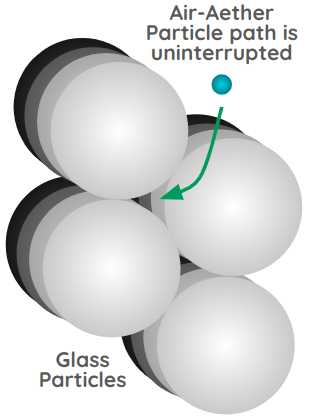Why is Glass Transparent?
Table of Contents
129. Why the fragility of glass decreases if it cools slowly
Glass is more fragile when it cools quickly than slowly.
Its channels are quite wide when glowing because the following pass through them:
- much fire-aether along with the air-aether globules
- some of the finer particles of the earth-aether
When it cools spontaneously, they become narrower.
- This is because only the air-aether globules passing through them require less space.
If cooling occurs too quickly, glass becomes hard before its channels can be constricted in this way.
- As a result, these globules always exert force later to separate its particles from each other.
These glass particles are joined solely by their own contact.
- When one gets separated even slightly, it will immediately separate more others beginning with those close to it on the surface where this separation began.
- This shatters the glass entirely.
This is why those who make glass vessels remove them gradually from the furnaces to cool slowly.
If cold glass is exposed to fire so that one part is heated much more than others nearby, it will break in that part.
This happens because the temperatue difference between the hot and cold parts of the glass causes the separation between the hot and cold particles.
- The hot parts get dilated, but the cold ones do not.
But if glass is heated slowly and then gradually subjected to stronger heat, all its parts get equally heated.
- It will not break because all its channels will be dilated equally and at the same time.
130. Why is glass transparent?
During its formation, glass is liquid.
The material of fire flows around its particles and carves many channels through which the air-aether globules pass freely.
- This lets the globules transfer the action of light in all directions along straight lines.
It is not necessary for these channels to be perfectly straight but only uninterrupted.

For example, glass can consist of perfectly thick, spherical, and equal particles that air-aether globules can pass through the triangular space between 3 mutually touching spheres.
- Such a glass will be completely transparent, even though it is much denser than the glass we currently have.
131. How does glass become colored?
The materials from which glass is made have particles which resist fire more and are not as easily smoothed as others that compose it.
When metals or other bodies are mixed with such materials, they become less transparent.
They acquire various colors depending on how these harder particles block its channels in different ways.
132. Why is glass rigid like an arch? Why do rigid bodies, when bent, spontaneously return to their original shape?
Glass is rigid. But when it is drawn into very thin threads, it can be bent somewhat by an external force without breaking.
But afterwards, it springs back with force like an arch and returns to its original shape.
This property of springing back generally applies to all hard bodies whose particles are connected by immediate contact, not by the interweaving of branches.
They have many shaped channels through which some matter is constantly moving.
When such bodies are bent, the shape of these channels are changed.
- This causes the matter particles, accustomed to passing through them, to impinge on their walls.
- This creates an opposing force to restore the original shape.
For example:
- a loose arch has circular channels through which the air-aether globules usually pass
- a tense or bent arch has elliptical channels
- The globules striving to pass through them impinge on their walls along the smaller diameters of these ellipses.
Thus, they have the force to restore the shape of the arch.
The force in each air-aether globule is small.
- But when combined with many that are constantly attempting to traverse the many pores in the same arch, their combined force can be significant.
A long-tense arch, especially if made of wood or some not very hard material, gradually loses the force of springing back.
- This is because its channels experience prolonged friction from the matter particles passing through them.
- This causes the shapes of its channels to gradually adapt more and more to their dimensions.